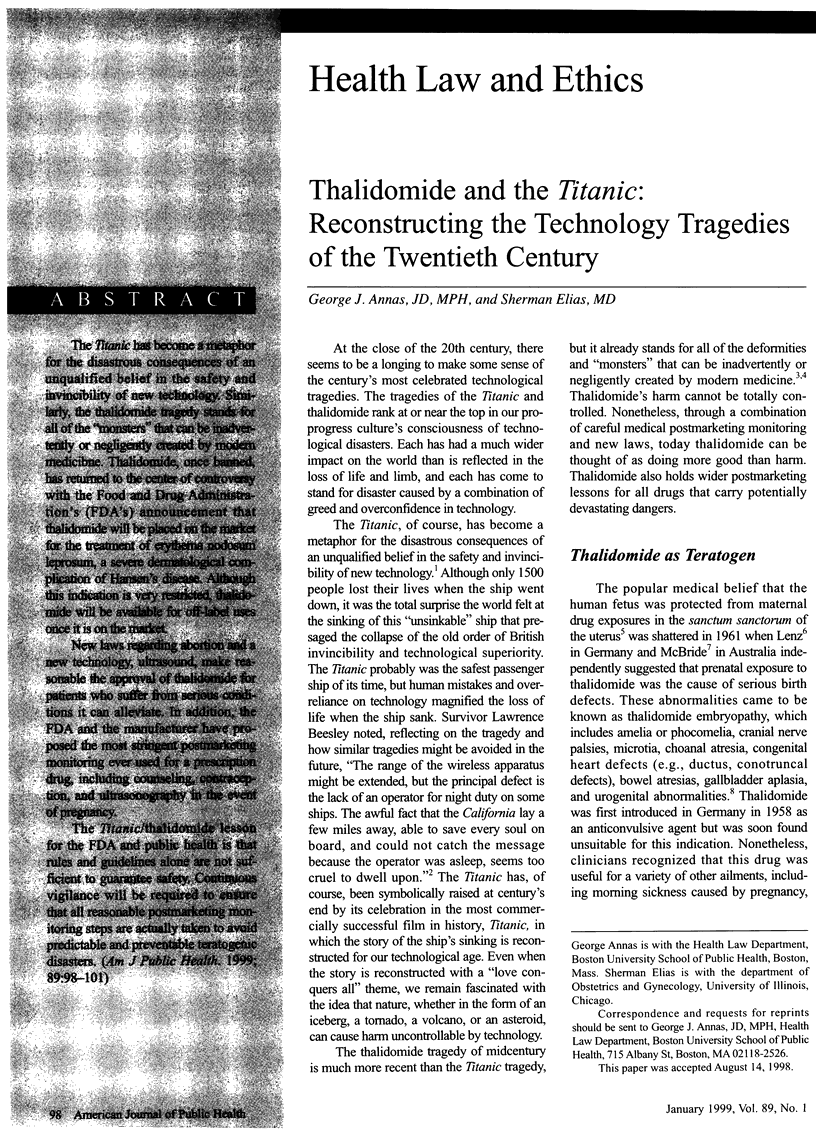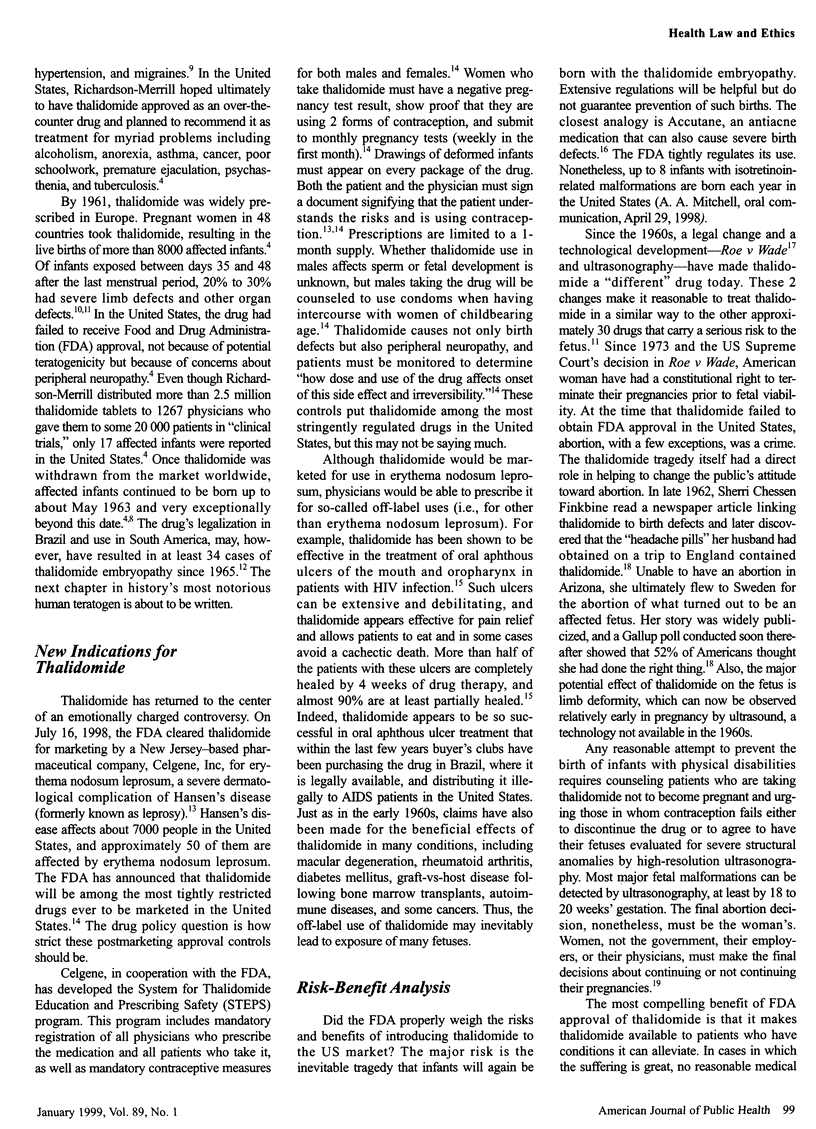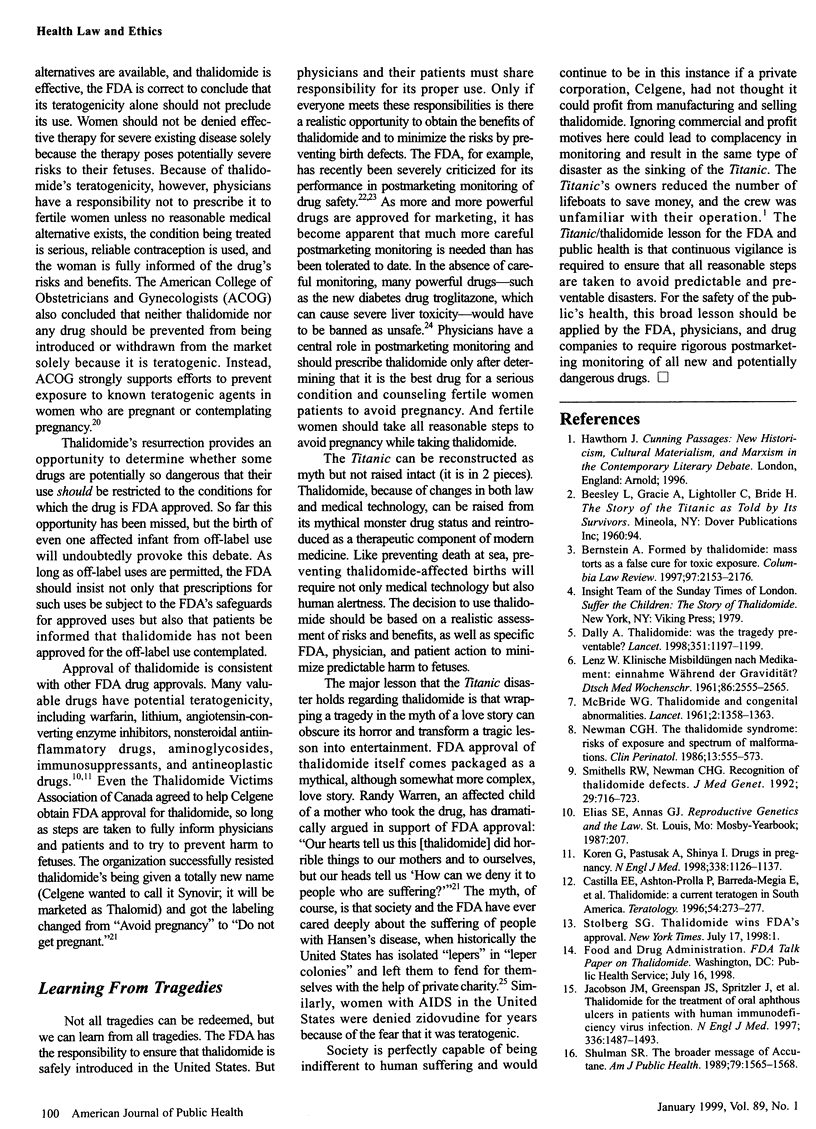Abstract
The Titanic has become a metaphor for the disastrous consequences of an unqualified belief in the safety and invincibility of new technology. Similarly, the thalidomide tragedy stands for all of the "monsters" that can be inadvertently or negligently created by modern medicine. Thalidomide, once banned, has returned to the center of controversy with the Food and Drug Administration's (FDA's) announcement that thalidomide will be placed on the market for the treatment of erythema nodosum leprosum, a severe dermatological complication of Hansen's disease. Although this indication is very restricted, thalidomide will be available for off-label uses once it is on the market. New laws regarding abortion and a new technology, ultrasound, make reasonable the approval of thalidomide for patients who suffer from serious conditions it can alleviate. In addition, the FDA and the manufacturer have proposed the most stringent postmarketing monitoring ever used for a prescription drug, including counseling, contraception, and ultrasonography in the event of pregnancy. The Titanic/thalidomide lesson for the FDA and public health is that rules and guidelines alone are not sufficient to guarantee safety. Continuous vigilance will be required to ensure that all reasonable postmarketing monitoring steps are actually taken to avoid predictable and preventable teratogenic disasters.
Full text
PDF



Selected References
These references are in PubMed. This may not be the complete list of references from this article.
- Annas G. J. Fetal protection and employment discrimination--the Johnson Controls case. N Engl J Med. 1991 Sep 5;325(10):740–743. doi: 10.1056/nejm199109053251020. [DOI] [PubMed] [Google Scholar]
- Bernstein A. Formed by thalidomide: mass torts as a false cure for toxic exposure. Columbia Law Rev. 1997 Nov;97(7):2153–2176. [PubMed] [Google Scholar]
- Castilla E. E., Ashton-Prolla P., Barreda-Mejia E., Brunoni D., Cavalcanti D. P., Correa-Neto J., Delgadillo J. L., Dutra M. G., Felix T., Giraldo A. Thalidomide, a current teratogen in South America. Teratology. 1996 Dec;54(6):273–277. doi: 10.1002/(SICI)1096-9926(199612)54:6<273::AID-TERA1>3.0.CO;2-#. [DOI] [PubMed] [Google Scholar]
- Dally A. Thalidomide: was the tragedy preventable? Lancet. 1998 Apr 18;351(9110):1197–1199. doi: 10.1016/S0140-6736(97)09038-7. [DOI] [PubMed] [Google Scholar]
- Jacobson J. M., Greenspan J. S., Spritzler J., Ketter N., Fahey J. L., Jackson J. B., Fox L., Chernoff M., Wu A. W., MacPhail L. A. Thalidomide for the treatment of oral aphthous ulcers in patients with human immunodeficiency virus infection. National Institute of Allergy and Infectious Diseases AIDS Clinical Trials Group. N Engl J Med. 1997 May 22;336(21):1487–1493. doi: 10.1056/NEJM199705223362103. [DOI] [PubMed] [Google Scholar]
- Koren G., Pastuszak A., Ito S. Drugs in pregnancy. N Engl J Med. 1998 Apr 16;338(16):1128–1137. doi: 10.1056/NEJM199804163381607. [DOI] [PubMed] [Google Scholar]
- Moore T. J., Psaty B. M., Furberg C. D. Time to act on drug safety. JAMA. 1998 May 20;279(19):1571–1573. doi: 10.1001/jama.279.19.1571. [DOI] [PubMed] [Google Scholar]
- Newman C. G. The thalidomide syndrome: risks of exposure and spectrum of malformations. Clin Perinatol. 1986 Sep;13(3):555–573. [PubMed] [Google Scholar]
- Shulman S. R. The broader message of accutane. Am J Public Health. 1989 Nov;79(11):1565–1568. doi: 10.2105/ajph.79.11.1565. [DOI] [PMC free article] [PubMed] [Google Scholar]
- Smithells R. W., Newman C. G. Recognition of thalidomide defects. J Med Genet. 1992 Oct;29(10):716–723. doi: 10.1136/jmg.29.10.716. [DOI] [PMC free article] [PubMed] [Google Scholar]


